Last Updated on
By David Link
Kestrel is a leading designer of portable weather meters and data loggers, and their devices can be applied to a staggering number of scenarios and uses. From agriculture and fire prevention to ballistics and hiking / camping, Kestrel meters can do a lot for professionals and hobbyists of all kinds. The upper echelon of Kestrel devices are used by environmental scientists and the military, while entry-level devices are great for outdoor enthusiasts and those just curious about basic weather measurements. Today I’ll be looking at one of Kestrel’s intermediate devices, the Kestrel DROP 3 Environmental Data Logger. This compact, lightweight device can do quite a lot once it’s connected to your iPhone or iPad.
A minor disclaimer, I’m not an environmental scientist by any means. However, I do have plenty of fascination and support for scientific endeavors and the methods that surround them. I can thank my hero Carl Sagan for that. This means I won’t be giving you a complex breakdown of how to use this device in scientific pursuits. Rather I’ll be giving you a layman’s review of the Kestrel DROP for camping and outdoor activities. One thing is for sure, if you purchase a Kestrel DROP, it will spark your curiosity around environmental factors and how they change around you.
Basics
The Kestrel DROP comes in three basic forms, and they are designed to fit different data logging demands. The DROP 1 ($69) is simply a temperature logger, and it will provide superior monitoring capability when compared to a basic thermometer. The DROP 2 ($99) adds three additional data points including humidity, heat index and dew point. The DROP 3 ($129) is the most sophisticated of the three and it logs several environmental factors to be summarized below. This is the model I’ll be looking at today.
The Kestrel DROP is extremely lightweight (1.2 oz.), and it has a pull tab attachment so you can keep it strapped to your pack or zipper via a carabiner or other device. The DROP needs to be exposed to open air to make precise readings, which means it’s best if you don’t keep it in your pocket or stowed in your bag. This said, exposing the DROP to sustained sunlight can skew its readings as well. You’ll have to find a middle ground to get the best data from the DROP.
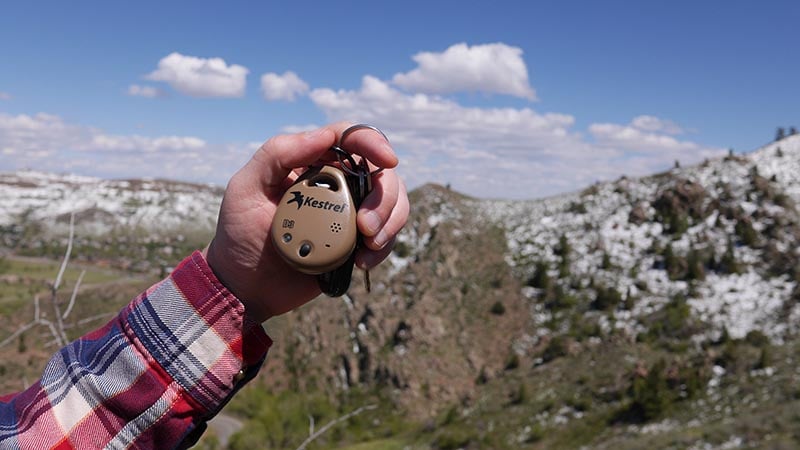
Setup of the device is easy and involves removing a pull tab on the battery to start the device. Your first step to logging data is to download the Kestrel App (free) on the iTunes App Store. Android compatibility is coming soon for Kestrel devices. I tested the Kestrel App on my iPhone 6. However, it’s important to note you’ll need recent iOS software to run the app, and if you’re still running an older iPhone or iOS, you may experience issues using the app. Bluetooth connectivity is required for the Kestrel DROP to transmit data to your phone.
Once the DROP battery is activated, the device starts to log data immediately. You’ll need to set up the initial DROP profile in the app, and then you can set log points to register every 2 seconds to every 12 hrs (with many intermediate points in between). You’ll get better battery life if you’re logging data points less frequently. So if you’re logging data every 2 seconds, you may not make it past the 6 month battery life. You can update these settings in the “Manage” section of the app. After some tinkering, I chose an intermediate time of 10 minutes for most uses. This is just for logging purposes, the device will still give you live updates on the dashboard. You’re also able to customize how often the dashboard refreshes.
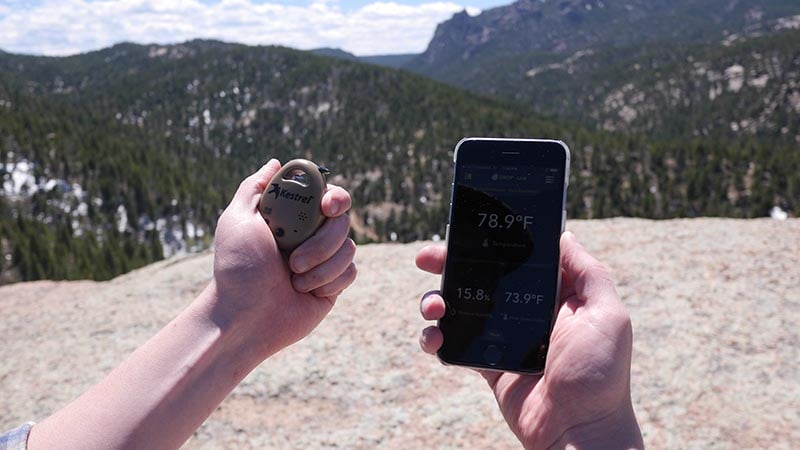
Specs
- Waterproof: Up to 1 meter for 30 minutes.
- Shockproof: Up to 4 ft. drop (may be able to sustain more).
- Weight: 1.2 oz.
- Dimensions: 2.4″ x 1.8″ x 0.9″.
- Temperature Range: Best operation at: 14°F/-10°C to 131°F/55°C, however can still log data at lower temperatures 0°F/-18°C (may effect battery life and data transmission).
- Storage Temperature: -22° F to 140° F / -30° C to 60° C, however device should not be connected via bluetooth at temperature extremes.
- Battery Life: 6 months to 1 year depending on how frequently data is logged and the temperatures device is used in.
- Battery Type: One replaceable CR2032 battery.
- Kestrel App: Free from iTunes App Store (Android support coming). App is highly customizable, and you can share data tables in a variety of ways (including Facebook uploads to show your friends just how much of a weather nerd you are).
- Bluetooth Connectivity: Works with Kestrel smartphone app (100 ft. connection range, best case scenarios).
In The Field
If you’re interested in the data options available in the DROP, read on below as I list them out. However, I’ll skip to how the Kestrel DROP performs in the field first. As noted above the DROP is extremely lightweight and you can take it anywhere. Equipping a small carabiner to the DROP is probably your best mounting option. It tested the tan color model, which is important to have if you ever plan to take it hunting. Just make sure you’re careful where you put it down because it does blend in easily, and its size doesn’t help. There are red and blue models available if you’re not concerned about visibility.
Device Range
Realistically, the range of 100 ft. is a best-case scenario range. Any obstructions, especially metal barriers, can reduce the range significantly. Water and snow can reduce range as well. I’ve paced out several different scenarios, and rarely did I get to 75 ft. before the device lost connection. This reduced distance shouldn’t worry you. Most of the time the device will be right next to you. Even if you lose connection to the DROP, it continues to log data. All you have to do is reconnect the device, and the measurements taken while away are populated into your app. Remember the Kestrel DROP is running all the time, and this can make for some fascinating observation opportunities.
Water Temperature Measurement
When it comes to measuring water temperature, the DROP works like a charm. I tested this by placing the device in cold water and monitoring it nearby with the app. The DROP actually floats, which in my opinion is a good thing. You’d end up losing it at the bottom of a river bed or frying the device if it went below 1 meter. What’s interesting is how the device floats. The lower portion keeps the device floating, while the top of the device with the measurement bulb is submerged underwater. This is truly ingenious design from Kestrel! You can measure water temp without losing the device. Once you take the DROP out of the water, it soon returns to measuring air temperature, and in the meantime you can get bonus Wet Bulb readings from the device.
Notes On Usage
I want to take a quick moment to talk about using the DROP in colder conditions. Once it gets below freezing, data transmission becomes harder for the DROP and this can really sap the battery. Using the DROP to measure colder temperatures is fine. Remember it is logging data even when it’s not connected to your phone. However, you’ll want to warm the Kestrel up before you connect it to your phone again. You can do this by holding it in your hand for a while or placing it in your pocket. Just something to keep in mind if you’re planning on measuring cold water or snow and ice frequently with the DROP.
Practical Applications
Ok, so what can you really use the Kestrel DROP for if you’re interested in one? Honestly the applications are too numerous to list here, and I’ll probably come up with more as I continue to tinker with it. For now here are a few practical application ideas:
- Measure Temperature Accurately – The drop provides precision measurements superior to that of a basic thermometer.
- Heat Safety – Humidity and heat stress index measurements can help you avoid situations where heat related illnesses are more likely.
- Camping and Hiking Conditions – You can keep an eye on the conditions while you’re out hiking or camping. This is especially useful when drastic changes in pressure indicate storms or the heat stress index climbs to a dangerous level.
- Supply Monitoring – You can observe when humidity and temperature levels will effect food stores or even hobbyist items like cigars.
- Hunting Situations – It has been theorized that deer are more active at higher pressures while they are more likely to bed down at lower pressures. It could be of great use to compare game movements to readings from your Kestrel DROP.
- Long Range Shooting Applications – High density altitude can effect how your bullet travels. Kestrel makes more advanced ballistic units if you want to dive into shooting applications further.
- General Curiosity – After all, every good scientist and thinker starts here, but it helps to have measurement tools.
- Teaching Basic Environmental Science – The smartphone app and a rugged handheld device make this a perfect medium for introducing both children and adults to some basic science concepts.
- Comment Below – Have you come up with an unique use for the DROP? If so let us know in the comments section below.
Data Options
Now on to the heavy science part of this review! The Kestrel DROP 3 Environmental Data Logger can track several environmental factors. Here is a quick summary of what it can do.
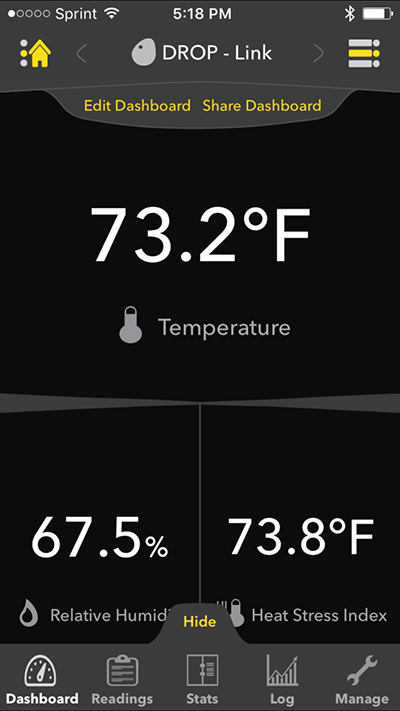
Temperature
Air, water and snow temperature can be measured by the Kestrel DROP. When measuring water or snow temperature, the device should not be left submerged longer than 30 minutes, and water or snow may effect data transmission distance.
Relative Humidity
Relative humidity is the ratio of the amount of water vapor in the air compared to how much water the air can hold at the current temperature. This measurement is shown as a percentage. In circumstances of high relative humidity, humans can experience greater distress in hot temperatures.
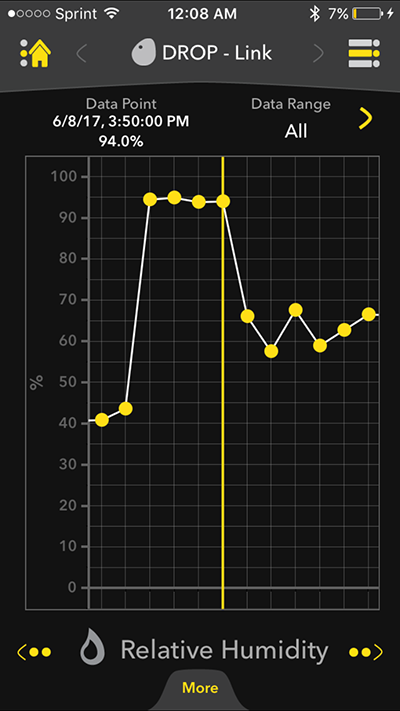
Heat Stress Index
A measurement that compares relative humidity to the current air temperature. Essentially this is a quick measurement to gauge how the body feels at warmer temperatures. At higher Heat Stress Index measurements, humans are at greater risk for heat exhaustion or other heat related illnesses. Before engaging in work or recreation outside, it’s best to check the Heat Stress Index. Note: The Heat Stress Index applies to activity in the shade. If a human is out in the sun, the risk of heat stroke greatly increases.
Here’s an excellent chart from NOAA that illustrates the Heat Stress Index: http://www.srh.weather.gov/jetstream/downloads/heatindex_rh_f_20x12.pdf
Dew Point
The temperature where water vapor in the air begins to condense. Essentially this is the point where the air can no longer hold all the water vapor, and a portion of it must transform to liquid. This measurement is often used to evaluate how likely it is a thunderstorm will develop.
Station Pressure
This is the actual air pressure at the location you’re measuring it from (i.e. your station). This measurement varies based upon your altitude. At lower altitudes there is more air pressing down upon you, which leads to a higher station pressure. However at higher altitudes there is less air above you, leading to lower station pressure readouts. Station pressure changes depending on the weather, which can make it a good forecaster of upcoming weather patterns. Large changes in pressure usually mean a storm is on the way.
Density Altitude
A measurement based upon the temperature, relative humidity, and air pressure of where you’re logging the data. This is displayed as a height above sea level, but this is not your actual altitude. Hot and humid temperatures can increase the density altitude, and this can have an effect on how an airplane, thrown object, or bullet performs in this environment. A good example of this is the baseball stadium near me, Coors Field. As the temperatures heat up and density altitude rises, the baseball flies even farther than it normally does in the Mile High City. Since we’re not pilots (and they certainly wouldn’t use the DROP for this anyway), the biggest use of density altitude would be for hunters and long distance shooters.
Final Thoughts
The Kestrel DROP has literally reignited my interest in tracking weather conditions and learning about more complex environmental factors. That alone is worth the purchase price! What’s great is Kestrel has made pursuing these interests affordable. The idea of buying a weather meter has rarely crossed my mind in the past. I figured they would be extremely expensive and so detailed that only working scientists could use them. That’s certainly not the case with the DROP, anyone can hone their basic science skills with this device. I would recommend either the DROP 2 or DROP 3 for most people, simply because it gives you more data to explore. At $99 and $129 respectively, this is still an affordable device for anyone interested in a portable weather meter.
Personally, I’ll use the Kestrel for camping, hiking and hunting purposes. Since I spend most of my outdoor time in the Rocky Mountains, pressure changes and rapid weather changes will give me plenty to study over the next few months. It will also help keep me safe should a violent storm show up on a trail or the heat index climb to an unsafe level. Finally, on an elk hunt this fall, I’ll get a chance to test the DROP in big game hunting scenarios. Really what you get out of the Kestrel DROP is renewed curiosity at the world around you. That is worth way more than what this cool little device costs.
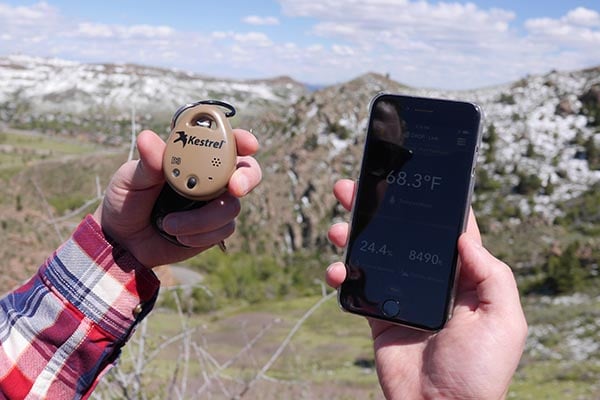
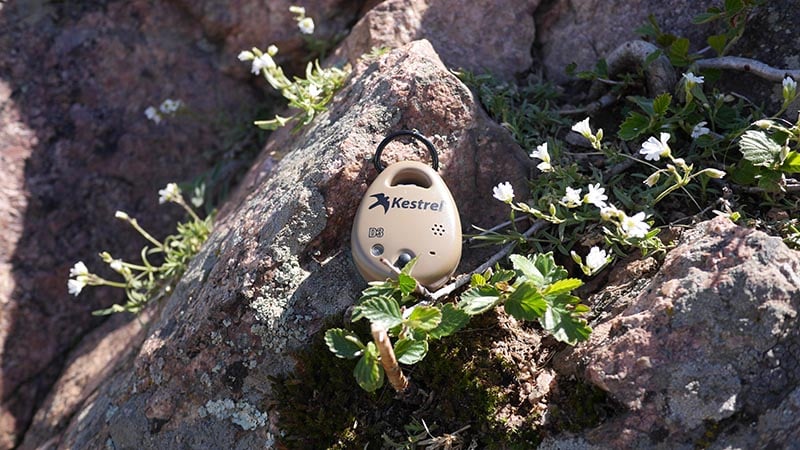
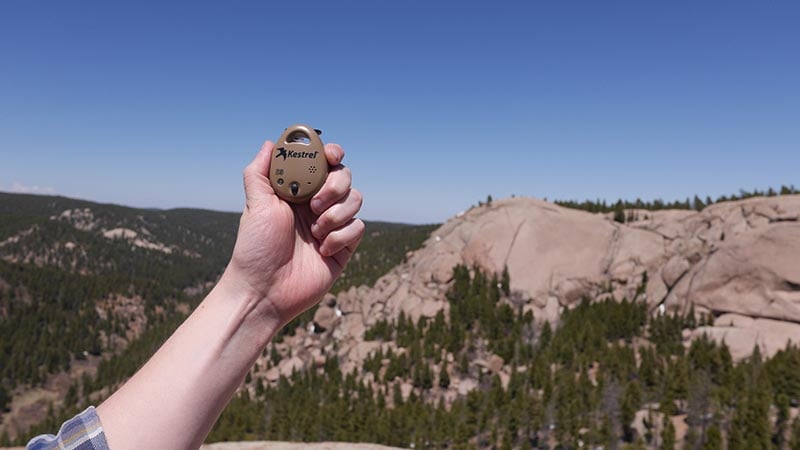
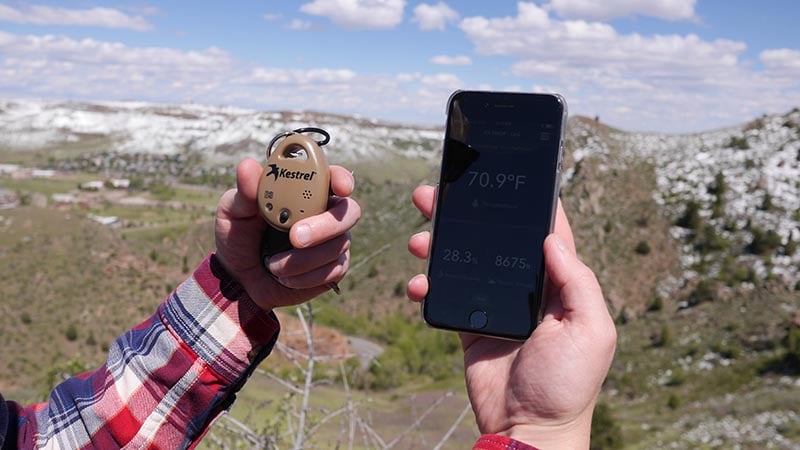
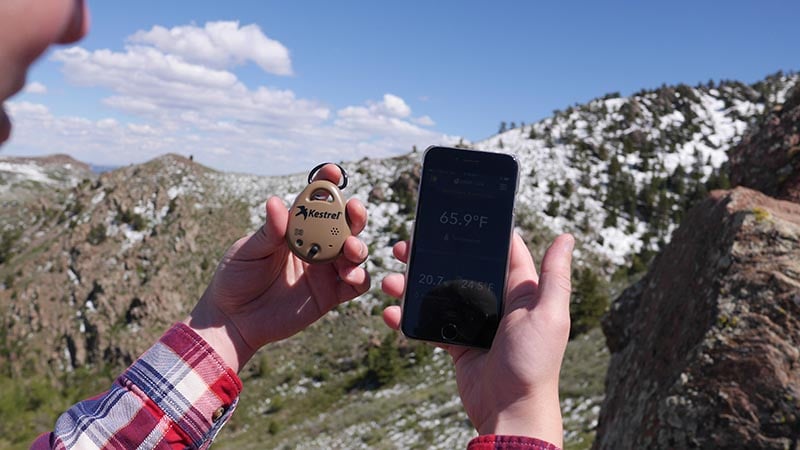
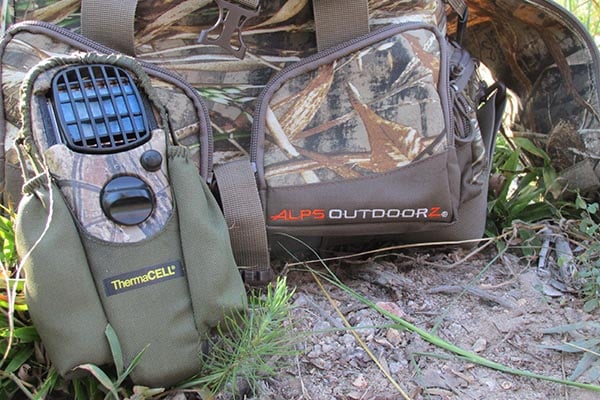
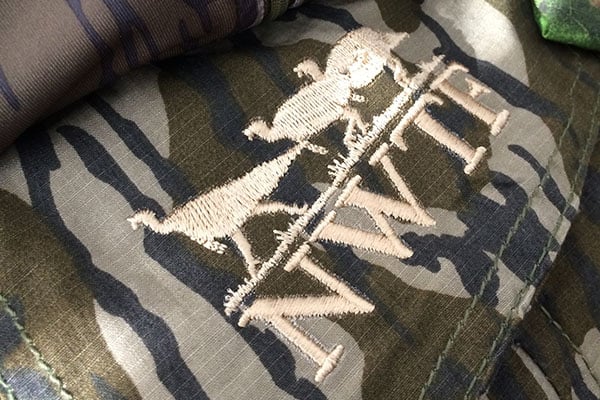
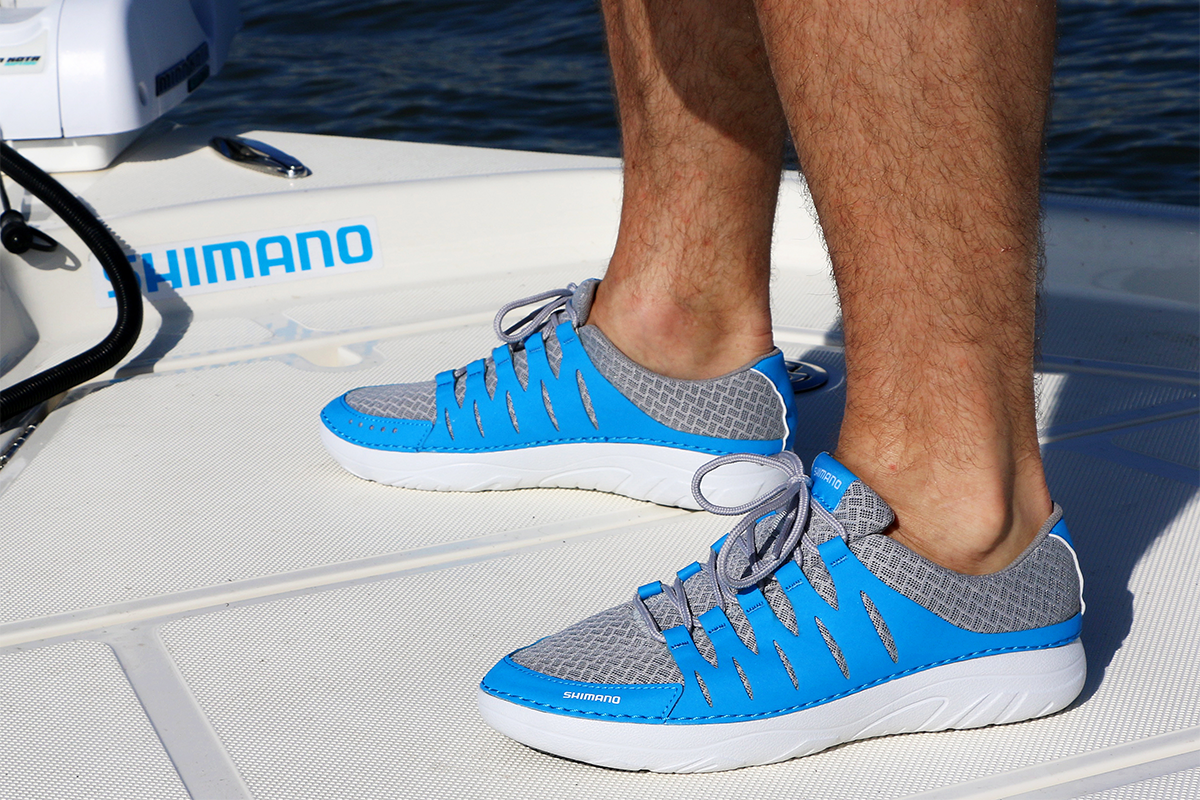

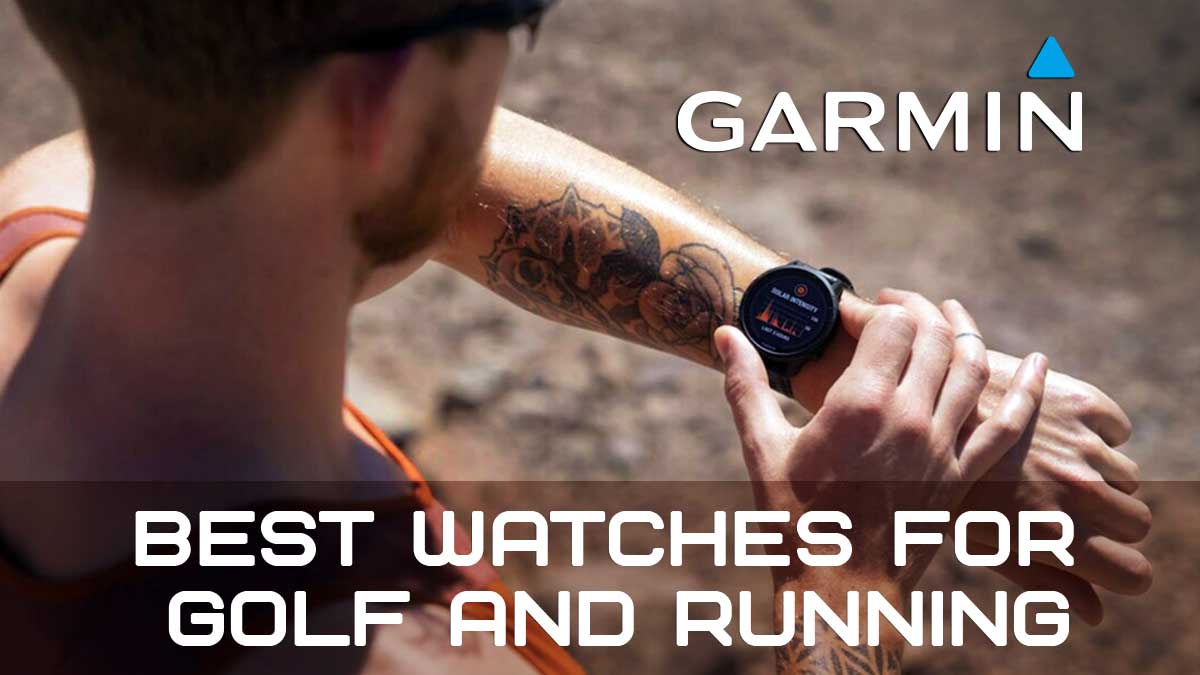


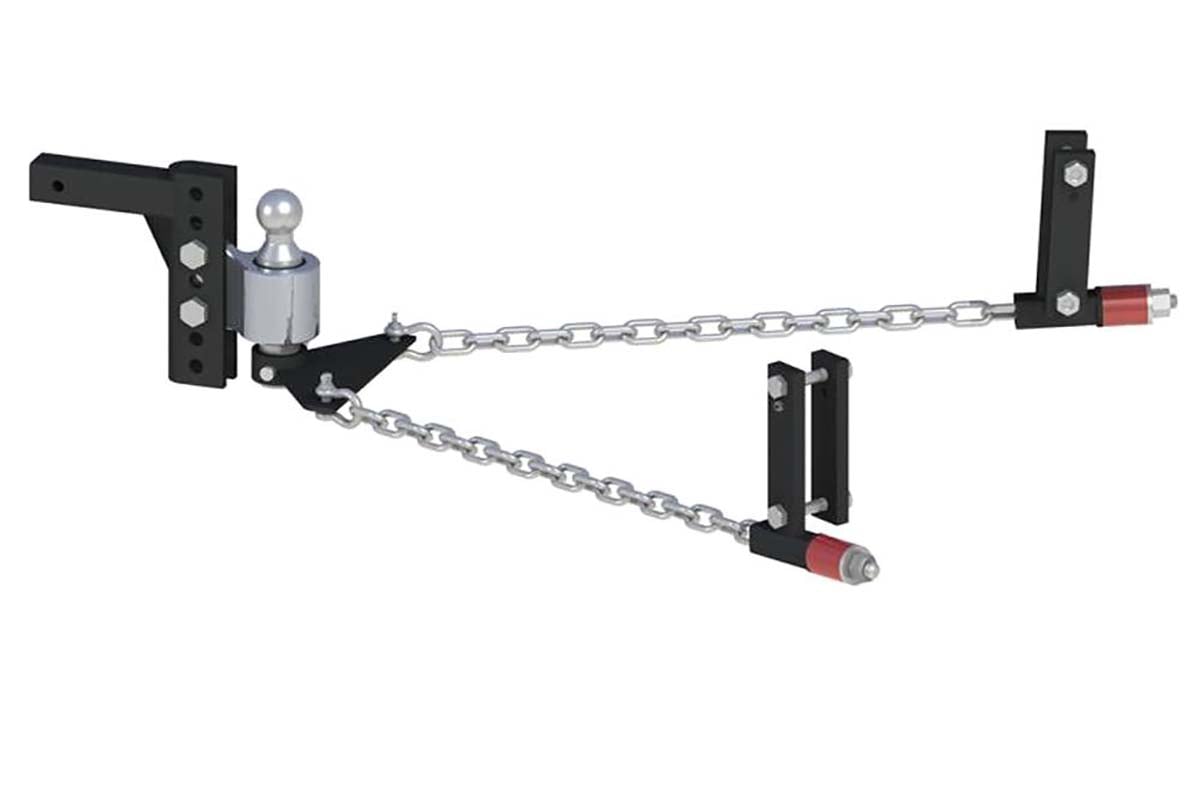



0 comments